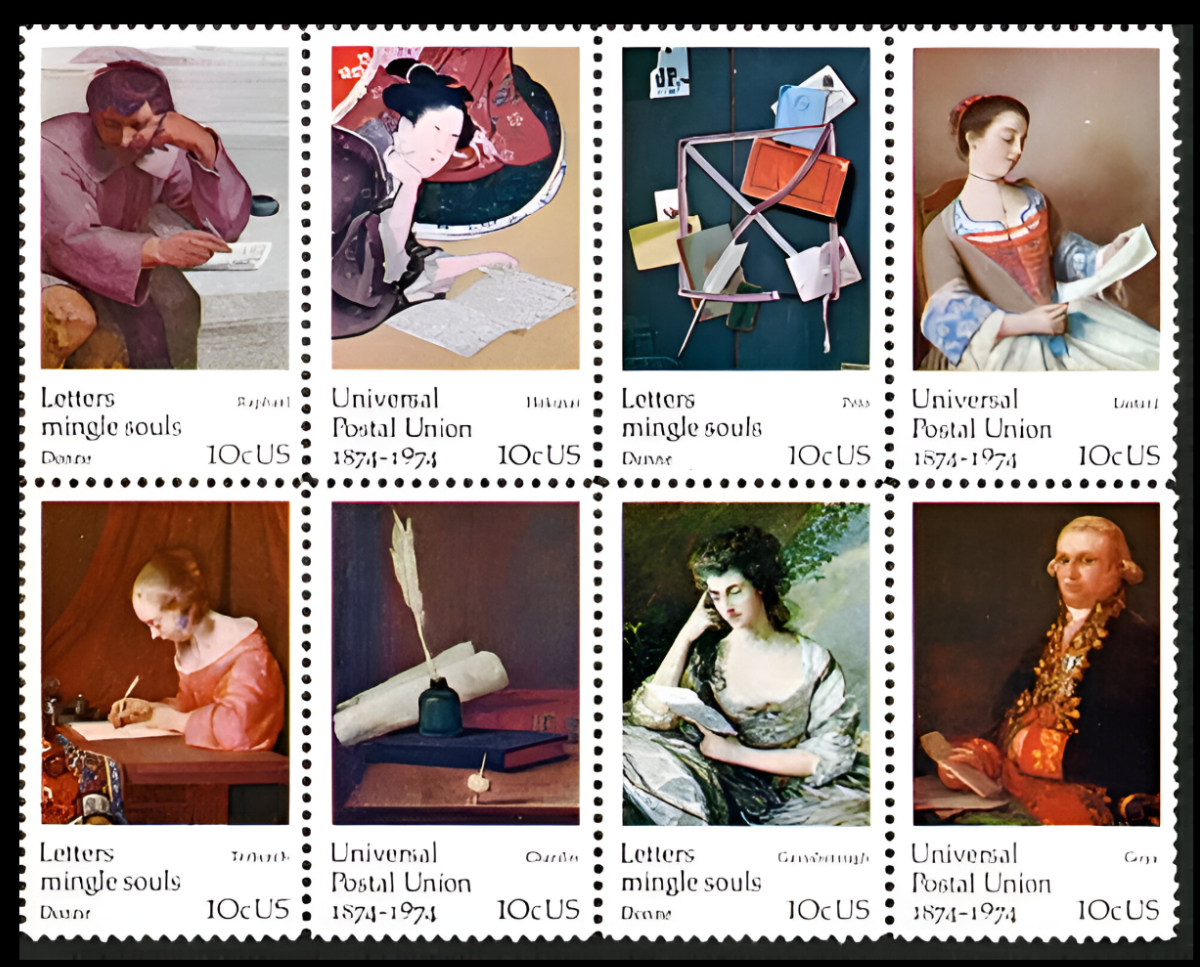
Famous Paintings on Stamps: The 1974 U.S. Universal Postal Union Commemoratives
In 1974, in recognition of the 100th anniversary of the founding of the Universal Postal Union, the United States Postal Service issued a beautiful set of commemorative stamps with the theme of reading and writing letters. The stamps illustrate the theme with fine art and a literary reference.
Each of the eight stamps in the set features a famous work of art by an internationally renowned artist that reflects the theme. The works of art range from the early 16th century to the late 19th century. In keeping with the international organization being honored, only one work is by an American. The other artists whose works are featured are Italian, Japanese, Swiss, Dutch, French, English, and Spanish.
The phrase “Letters mingle souls,” a quotation from a poem by John Donne, appears on every second stamp. The centennial that is being commemorated, “Universal Postal Union 1874–1974,” appears on the others. All eight are ten-cent stamps—the first-class domestic postage rate in 1974.
What Is the Universal Postal Union?
The Universal Postal Union (UPU) is the foundation of the modern global postal system, facilitating mail delivery between member nations throughout the world.
For many centuries, mail was carried by messengers, and long-distance mail was almost exclusively the province of kings and large institutions such as religious orders and universities. As trade and commerce developed, nations entered into bilateral postal agreements. But by the 19th century, the web of agreements made international postal service cumbersome and inefficient.

The Universal Postal Union flag. (Denelson83, CC BY-SA 3.0 , via Wikimedia Commons)
In 1863, postal officials in the United States called for a postal congress to simplify international mail delivery, but no action was taken. In 1874, German postal official Heinrich von Stephan drew up a plan for an international postal union, and the Swiss government convened a conference to study the plan. On October 9, 1874, 21 countries signed the Treaty of Bern, setting up the General Postal Union. Membership increased so rapidly that in 1878 the organization was renamed the Universal Postal Union.
The Universal Postal Union, the second oldest international organization (after the International Telegraph Union, founded in 1865), is now an agency of the United Nations with 192 members.
The Theme of the Art: "Letters Mingle Souls" from John Donne
The inscription “Letters mingle souls” on every second stamp in the set is a quotation from the first line of John Donne’s poem “To Sir Henry Wotton”:
Sir, more than kisses, letters mingle souls,
For thus, friends absent speak. This ease controls
The tediousness of my life; but for these
I could ideate nothing which could please …
Donne and Wotton were friends, and in these lines, Donne uses hyperbole to express the great importance to him of letters between friends. Letters, says Donne, can bring friends’ true selves together. Without letters, life can be tedious and pleasure hard to find.
In a world before telephones, email, or social media—which, of course, was the world both in Donne’s time and in 1874 when the UPU was founded—letters were the best medium for staying connected over long distances.

Portrait of John Donne c. 1595. (Unknown artist, National Portrait Gallery, Public domain, via Wikimedia Commons)
John Donne (1572–1631)
John Donne was a prolific English poet, as well as a lawyer, priest, and member of Parliament. His early poetry included much satire as well as erotic imagery. In his later work, he turned to more pious themes in his poetry and also published numerous sermons.
Donne is considered the preeminent representative of the English metaphysical poets, whose poetic style emphasized inventive and extended metaphors. He is perhaps best known for his poem “Meditation XVII,” which included the often quoted phrases “No man is an island…” and “…never send to know for whom the bell tolls; it tolls for thee.”
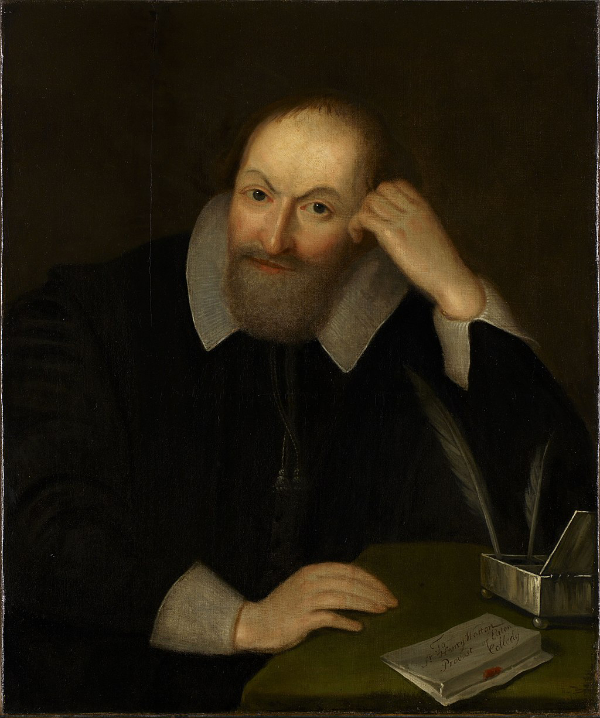
Portrait of Sir Henry Wotton c. 1630–1650. (U.K. Government Art Collection, Public domain, via Wikimedia Commons)
Sir Henry Wotton (1568–1639)
Donne developed a friendship with Henry Wotton while both were students at Oxford. Wotton was a poet too, but he spent his career primarily as a diplomat.
Wotten and other diplomats of his day communicated primarily by letter. In 1602, for example, when Wotton was living in Florence, the Grand Duke of Tuscany entrusted him with sensitive letters to King James VI of Scotland warning the latter of a plot to assassinate him. The plot was foiled, and the following year James acceded to the throne of England as King James I. In gratitude for Wotton’s service, James knighted him and appointed him ambassador to the court at Venice.
Raphael, Heraclitus from 'School of Athens' (1510–1511)
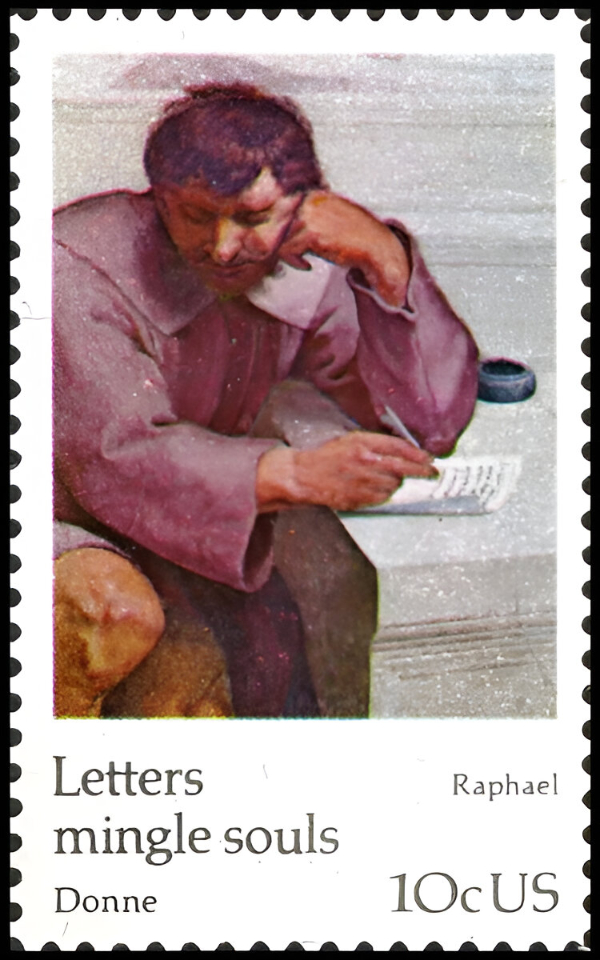
Raphael, Heraclitus from School of Athens. (Scan by Brian Lokker)
Raphael (Raffaello Sanzio da Urbino) (1483–1520) was an Italian painter of the High Renaissance. One of the three acknowledged masters of the period, along with Michelangelo and Leonardo da Vinci, Raphael was exceptionally productive during his short lifetime.
School of Athens (Scuola di Atene) is one of Raphael’s most famous works. Commissioned by Pope Julius II, it is one of three frescoes that Raphael painted in the Stanza della Segnatura in the Apostolic Palace in the Vatican.
The painting depicts numerous ancient Greek philosophers and scientists, who were “seeking knowledge of causes,” as the title above the fresco suggests. Although none of the persons in the painting are identified, and Raphael left no notes, scholars agree that the central figures are Plato and Aristotle.
The figure depicted on the stamp is generally agreed to be Heraclitus, whose features Raphael modeled on his contemporary, Michelangelo (just as he modeled Plato on Leonardo da Vinci). Heraclitus was known for his treatise On Nature. The fact that Raphael shows him sitting apart from the other philosophers, writing, may be fitting, as scholars have speculated that Heraclitus suffered from melancholia.
Where is the original? The fresco School of Athens is located in Raphael’s Rooms at the Vatican, which are included in tours of the Vatican Museums.
Katsushika Hokusai, Woman Representing Literacy from 'Five Beautiful Women' (1804–1818)

Katsushika Hokusai, Woman Representing Literacy, from Five Beautiful Women. (Scan by Brian Lokker)
Katsushika Hokusai (1760–1849) was a Japanese painter and printmaker of the Edo period. Considered one of the greatest artists of the Ukiyo-e “pictures of the floating world” school, he is recognized for broadening the style from the traditional portraits of courtesans and artists to include landscapes, plants, animals, and views of everyday life.
Hokusai is best known for his woodblock print series Thirty-six Views of Mount Fuji (c. 1826–1833). The first print in the series, The Great Wave off Kanagawa, became an internationally recognized image. Hokusai’s prints were imported to Paris in the mid-1800s, and his work influenced numerous Impressionists.
Five Beautiful Women, a hanging silk scroll, depicts five women, arranged vertically. The women are thought to represent, from top to bottom, the five Confucian feminine virtues: poetry, flower arranging, domesticity, entertainment, and literacy. The woman shown on the stamp, the representative of literacy, is reading a letter or small book.
Where is the original? Five Beautiful Women (ink and color on silk) is in the collection of the Seattle Art Museum, Seattle, Washington.
John Frederick Peto, 'Old Time Letter Rack' (1894)
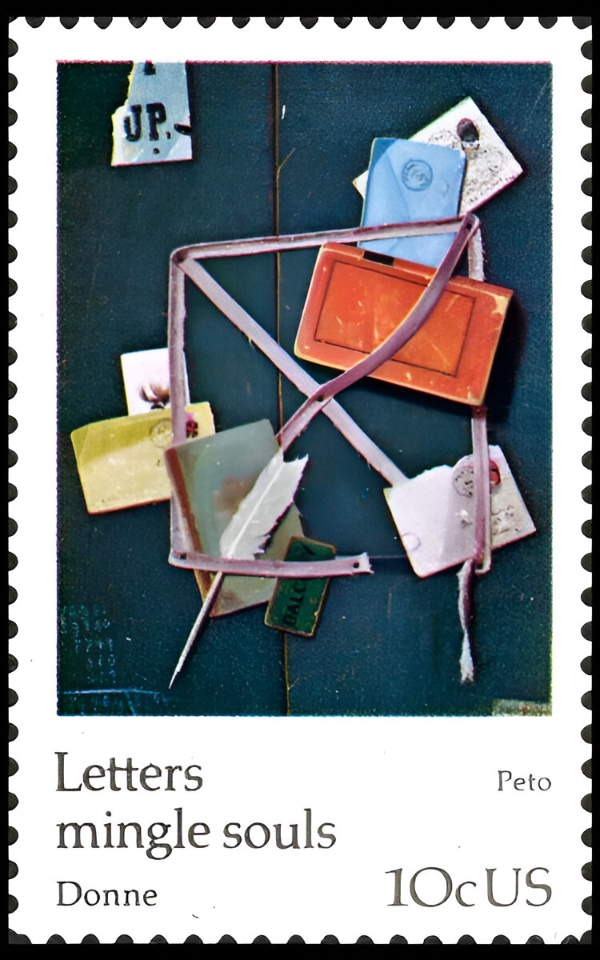
John Frederick Peto, Old Time Letter Rack. (Scan by Brian Lokker)
John Frederick Peto (1854–1907) was an American painter. Although he was trained at the Pennsylvania Academy of Fine Arts, he worked mostly in obscurity. He did not earn his living as a painter, and he never had an exhibition at a gallery during his lifetime. His work was rediscovered later in the 20th century along with that of his friend and fellow trompe l’oeil artist William Michael Harnett.
Peto was a master of the trompe l’oeil (“fool the eye”) genre of still life painting. His subjects often included mundane objects, such as books, pieces of papers, candlesticks, photographs, and keys, frequently arranged on a tabletop.
Old Time Letter Rack is an important example of a “rack painting,” another type of trompe l’oeil composition at which Peto excelled. The painting features several letters and a quill pen among other objects. They are arranged on a vertical surface, attached by a pattern of ribbons. Rack paintings were often painted for businessmen, with the objects being selected to reflect aspects of the client’s life and career.
Old Time Letter Rack was for many years erroneously titled Old Scraps and attributed to Harnett. In 1947 art critic Alfred Frankenstein correctly reattributed the painting to Peto. After restoration, Peto’s signature and original title were revealed.
Where Is the Original? Old Time Letter Rack (oil on canvas) is in the private collection of Richard A. Manoogian of Grosse Pointe, Michigan. It has been exhibited at numerous museums, including the National Gallery of Art in Washington, D.C.
Jean-Étienne Liotard, 'La liseuse' (1746)

Jean-Étienne Liotard, La liseuse. (Scan by Brian Lokker)
Jean-Étienne Liotard (1702–1789) was a versatile Swiss painter. He is most well-known for his pastel drawings, but he also worked in many other media, including engravings, enamels, and glass paintings.
Liotard studied in Geneva and Paris and traveled extensively throughout continental Europe, England, and Turkey. Among the notable subjects of his portraits were Pope Clement XII and Augusta, Princess of Wales. While in Turkey, Liotard adopted an eccentric oriental dress and became known as the “Turkish painter.”
Liotard also wrote a Treatise on the Art of Painting, and he was an expert art collector, especially of old masters. His own works may be found in many museums, including the Victoria and Albert Museum and the British Museum in London, the Louvre in Paris, and the Rijksmuseum in Amsterdam.
La liseuse (The Reader) is an exquisite example of Liotard’s pastel portraits. The subject is Liotard’s niece, Marianne Lavergne, dressed in clothing typical of rural Lyons, France, and reading a letter.
Where Is the original? La liseuse is in the collection of the Rijksmuseum in Amsterdam, Netherlands.
Gerard ter Borch, 'De Briefschrijfster' (c. 1655)
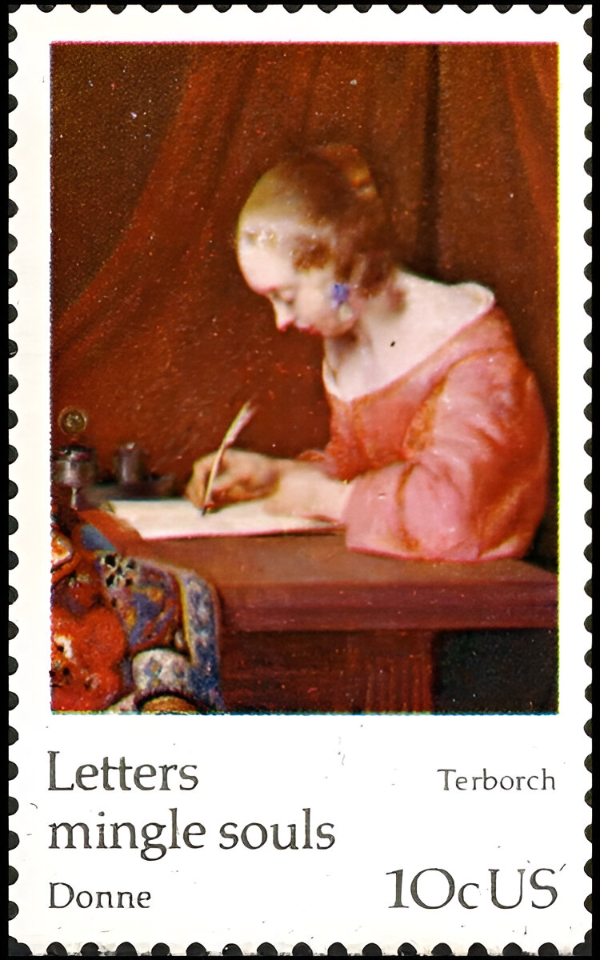
Gerard ter Borch, Woman Writing a Letter. (Scan by Brian Lokker)
Gerard ter Borch (1617–1681) was a Dutch painter of the Golden Age. His father and sister were also artists, and ter Borch’s talent was recognized and developed at a young age. He traveled widely throughout Europe and is known to have painted in Rome and in Germany as well as in the Netherlands.
Ter Borch is known for both portraits and genre painting—scenes of everyday life, in which people are engaged in ordinary activities, work, and recreation. His genre paintings are noteworthy for their exquisitely drawn figures, gracefully arranged groups, and masterful handling of color. He is especially noted for his ability to paint satin and other surface textures.
All of these characteristics are displayed in De Briefschrijfster (Woman Writing a Letter), one of his finest genre paintings. The graceful woman in the painting appears totally engrossed in writing her letter, unaware of anything other than the task before her.
Where is the original? De Briefschrijfster (oil on wood) is part of the collection of The Mauritshuis art museum in The Hague, Netherlands.
Jean-Baptiste-Siméon Chardin, Inkwell and Quill from 'L'Enfant au toton' (c. 1738)

Jean-Baptiste-Siméon Chardin, Inkwell and Quill from Boy with a Top. (Scan by Brian Lokker)
Jean-Baptiste-Siméon Chardin (1699–1799) was a French painter. He is considered the greatest still-life painter of the 18th century, as well as a master of domestic genre painting. L’Enfant au toton (Boy with a Spinning Top) is an outstanding example of his work.
Chardin was born in Paris and throughout his life seldom left the city. In 1728 he was admitted to the Académie Royale de Peinture et de Sculpture. Thereafter he exhibited regularly at the Academy’s Salon and served in several official positions in the Academy throughout his career. He became quite famous and influential. Louis XV gave him an annual pension and purchased his work. In later life, however, Chardin turned from oils to pastels, which were not admired until after his death.
Chardin’s genre paintings were influenced by the Dutch masters of the 17th century. Many of these paintings feature scenes of the Parisian petite bourgeoisie, who had seldom before been depicted in art. Chardin was noted for his sensitive yet unsentimental portrayal of the innocence of children.
Where is the original? L’Enfant au toton (oil on canvas) is in the collection of La Louvre in Paris, France.
Thomas Gainsborough, 'Frances Browne, Mrs. John Douglas' (1783–1784)
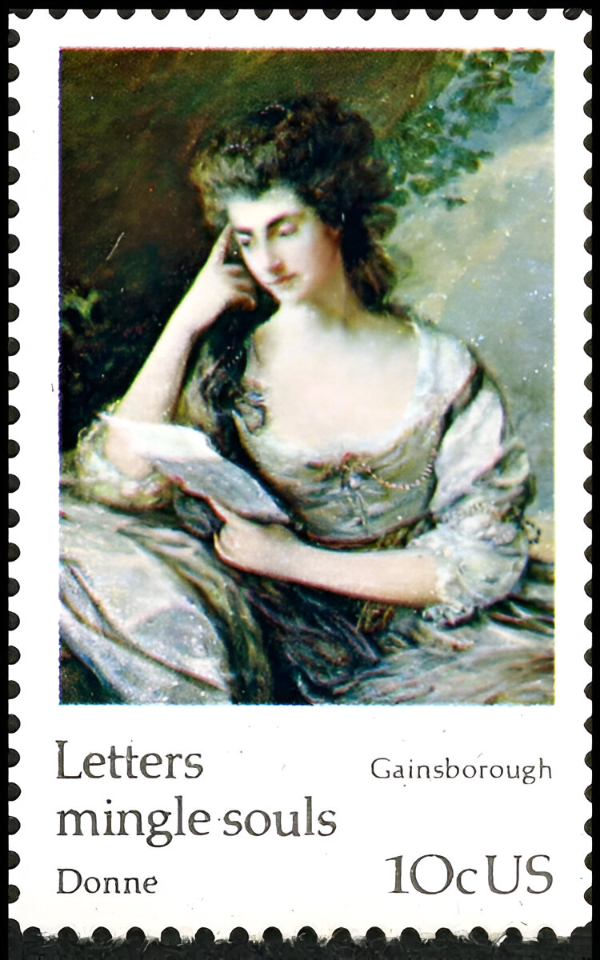
Thomas Gainsborough, Mrs. John Douglas. (Scan by Brian Lokker)
Thomas Gainsborough (1727–1788) was an English portrait and landscape painter. He began as a landscape painter in Suffolk and always said that landscape was his first love. His landscapes were influenced both by French Rococo design and by 17th-century Dutch landscape painters.
In 1759 Gainsborough moved to Bath to gain access to a wider audience. In Bath, most of his work was portraiture, for which he adopted a more elegant and formal style that appealed to his sophisticated, fashionable clients. In the 1760s he began to exhibit his work regularly in London, and in 1768 he was elected as a founding member of the Royal Academy.
Gainsborough moved to London in 1774 and became a favorite of George III, who preferred him to the official court painter, Sir Joshua Reynolds. Although he was one of England’s most important portrait painters, he is also credited as a pre-eminent landscape painter. He was known as an innovator who experimented with numerous other techniques and media, including watercolor, chalk, pen and ink, and etchings.
The portrait reproduced on the stamp is a fine example of Gainsborough’s ability to integrate the subject of his portraits with the landscape in the background. He achieved this result through the naturalness of the sitter’s pose and a consistent use of color and texture for both the sitter and the landscape.
Where is the original? Frances Browne (Mrs. John Douglas) (oil on canvas) is in the collection at Waddesdon Manor in Aylesbury, Buckinghamshire, in the United Kingdom.
Francisco Goya, 'Don Antonio Noriega' (1801)
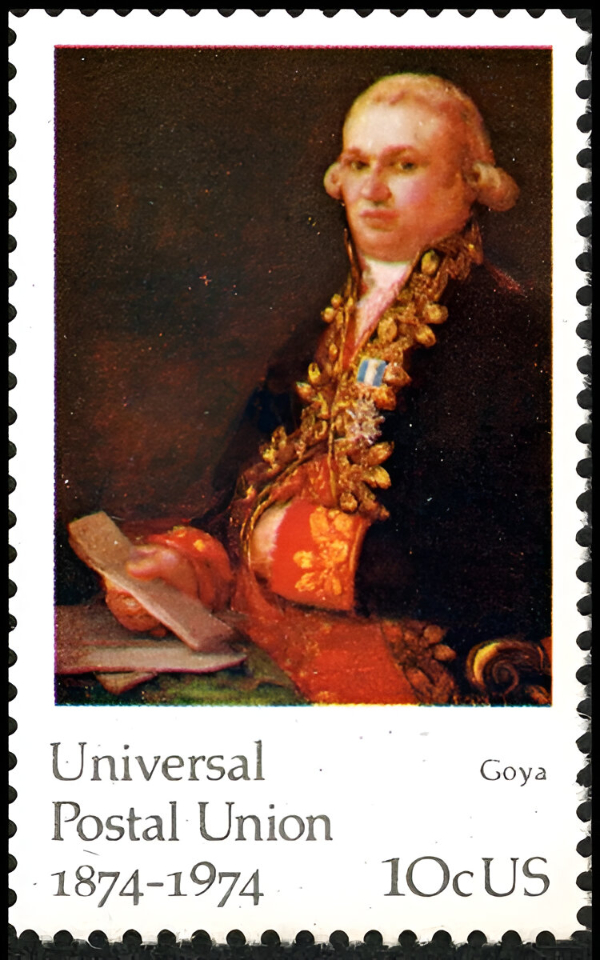
Francisco Goya, Don Antonio Noriega. (Scan by Brian Lokker)
Francisco José de Goya y Lucientes (1746–1828) was a prolific Spanish artist whose body of work included numerous paintings, drawings, and engravings. Living in a time of political and social change, his work reflected artistic change as well. He is considered to be both one of the last Old Masters and one of the first modern artists.
After studying in Aragón, where he was born, and in Madrid and Rome, Goya received commissions to paint frescoes in Aragón and patterns for the Royal Tapestry Factory in Madrid, among others. In recognition of the quality of his work, he was appointed as a member of the Royal Academy of Fine Art.
Goya also attracted powerful patrons among the nobility, and in 1786 he obtained a position as painter to King Charles III. In 1799 Charles IV appointed him as First Court Painter. Despite the patronage of the king and nobility, Goya’s portraits were remarkably honest, revealing hints of corruption and decay beneath the pomp.
After the French invaded Spain in 1808, leading to the Peninsular War of 1808 to 1814, Goya’s work included more explicit social and political commentary. Between 1810 and 1820, he produced a set of 82 aquatint prints, “The Disasters of War,” that were unflinching portrayals of war and its effects on society and are among Goya’s most famous works.
Don Antonio Noriega Bermudéz, the subject of the portrait on the stamp, was Spain’s General Treasurer under Charles IV. Noriega was knighted in 1801, and Goya’s portrait of Noriega reading a letter may have been commissioned to commemorate that event.
Where is the original? Don Antonio Noriega (oil on canvas) is part of the Samuel H. Kress Collection and is on view in the National Gallery of Art, located on the Mall in Washington, D.C.
These Famous Paintings on Stamps Are a Miniature Art Gallery
This 1974 issue commemorating the centennial of the Universal Postal Union is one of the most visually rich sets of stamps ever issued by the U.S. Postal Service. Like an art gallery in miniature, the stamps showcase eight of the world’s great masterpieces of art.
Originally sold for only ten cents each, these works of art even now are available to collectors for only a few dollars. Stamp collecting can be a very rewarding and educational hobby. If you have these stamps in your collection, it’s not only a stamp collection — it’s an art collection too.
Copyright © Brian Lokker 2012, 2024. An earlier version of this article was published on HubPages.com and subsequently featured on HobbyLark.com.




